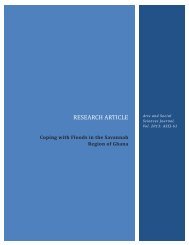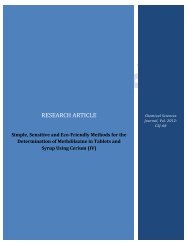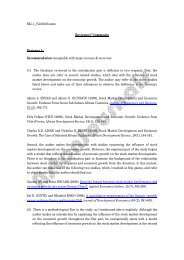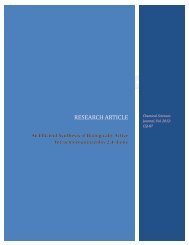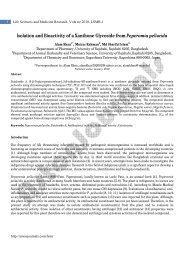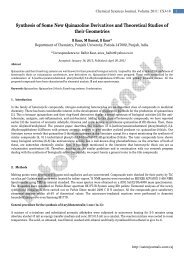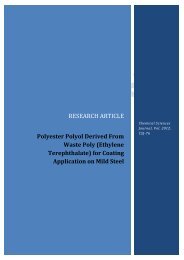4 Research ArticleTable 1: Co-segregation <strong>of</strong> <strong>Fusarium</strong>-wilt reaction on forced inoculated F 2 individuals (200) <strong>of</strong> cas<strong>to</strong>r beanhybrid, GCH-4 and the three <strong>RAPD</strong> markers.F 2 Population χ2 Probability RecombinationResistance (R) Susceptible (r) (3:1) FractionPhenotyping <strong>of</strong> F 2F 2 Individuals 144 56 0.91 0.05Genotyping <strong>of</strong> F 2<strong>RAPD</strong> Marker RR Rr a rR b rr Rr a rR bOPBE 18 146 6 4 44 0.42 0 0.015 0.010RKC 21 137 9 6 48 0.61 0 0.023 0.015RKC 23 140 5 10 45 0.59 0 0.013 0.025r a Phenotyically resistant but devoid <strong>of</strong> DNA markers.R b Phenotyically susceptible but contains DNA markers.3.2. <strong>RAPD</strong> screeningA <strong>to</strong>tal <strong>of</strong> 64 arbitrary decamer primers were used for <strong>RAPD</strong> analyses for detecting variability amongst theparents. The number <strong>of</strong> amplified products by each primer varied from 0 <strong>to</strong> 31 with an average <strong>of</strong> 13.8 bandsper primer, and the amplified products ranges from 200 bp <strong>to</strong> 2100 bp. Only the easily scorable and consistentpr<strong>of</strong>ile <strong>of</strong> the <strong>RAPD</strong> was analyzed for all the primers used. The percent polymorphism was from 0–100 %. TheF 2 and F 3 segregating populations <strong>of</strong> GCH-4 along with the two parents viz. 48-1 and VP-1 were screened with104 <strong>RAPD</strong> primers for fusarium-wilt reaction under forced inoculation conditions. Three replica analyses foreach experiment were performed. Among the primers showing polymorphism between the two genotypes,only three primers, viz OPBE 18, RKC 21 and RKC 23, were selected for further studies, since they generatedamplification products that were present in resistant parents and resistant bulks but absent in susceptibleparent and susceptible bulks. The polymorphism was confirmed by repeated amplification experiments bycomparing with parents, resistant and susceptible bulks. The F 2 and F 3 bulk segregated analysis for theresistance locus, resulted <strong>to</strong>, 1:1 segregation ratio.3.3. Genotyping <strong>of</strong> F 2 and F 3 populations segregating for <strong>Fusarium</strong>-wilt reactionThe polymorphic primers OPBE-18, RKC 21 and RKC 23 were used <strong>to</strong> know the genotypes <strong>of</strong> the individuals <strong>of</strong>known phenotypes (fusarium-wilt resistant) from the F 2 population and F 3 population. The OPBE18 primergenerated 900bp DNA band for all the fusarium wilt resistant 146 out <strong>of</strong> 200 F 2 individuals, which followed thesegregation ratio <strong>of</strong> almost 3:1 (Table 1). This primer generated 900bp band in 92 F 3 resistant individuals out <strong>of</strong>100 plants tested for fusarium wilt reaction. The 3 randomly selected F 2 plants whose progenies weresegregated for the resistant gene were heterozygous and the non-segregated seeds <strong>of</strong> rest F 2 plants werehomozygous for the fusarium-wilt resistance gene. Similarly, RKC-21 and RKC-23 generated 1080 bp and 1375bp DNA bands in F 2 and F 3 individuals respectively whose segregation followed the simple Mendelianinheritance (Table 1). Linkage analysis carried out on the 200 F 2 individuals showed the genetic distance for thethree markers (RKC 23 1375, OPBE 18 900 and RKC 21 1080 ) <strong>linked</strong> <strong>to</strong> the wilt resistance gene as 5, 10.7 and 7.6 cMrespectively, calculated as described in materials and methods (Figure 1).3.4. DNA marker sequence analysis<strong>Development</strong> <strong>of</strong> DNA marker is essential in both marker-assisted selection and characterization <strong>of</strong> anyimportant gene, so the three markers developed in our report were sequenced and characterized. Homologysearches using GenBank and EMBL accessions using BLASTN showed that the three markers do not show anysignificant similarities <strong>to</strong> any <strong>of</strong> the accession in either <strong>of</strong> the databases. The sequences were modified byeliminating noncoding fragments by biocomputing <strong>to</strong>ols. Among the three markers sequences, the modified900 bp sequence <strong>of</strong> RKC 23 was characterized in details and was designated as FOR1. The modified sequencewas subjected <strong>to</strong> Translation <strong>to</strong>ol <strong>of</strong> the NCBI, <strong>to</strong> get the different frames. To assign possible biological function<strong>of</strong> the putative amino acid sequence <strong>of</strong> the modified RKC 23 marker, it was compared with the proteinsequences submitted in the publicly accessible databases and have shown significant similarities <strong>to</strong> theputative proline rich protein (Oryza sativa), PRP gene (Zea mays), cell division protein (Arabidopsis thaliana),nodule protein (ENOD2) (Pisum sativum). Secondary structure and fold recognition <strong>of</strong> the translated 3 / 5 / frame2 by Phyre databases gave some similarity with defensive-like protein (d1eLqa) from defensive family. Multiplesequence alignments and phylogram were generated using Clustal W alignment <strong>of</strong> the translated protein withother eight protein sequences. Translated amino acid sequence <strong>of</strong> marker RKC 23 and DNA binding proteinhttp://as<strong>to</strong>njournals.com/gebj
Genetic Engineering and Biotechnology Journal, Vol. 2011: GEBJ-285shared the same cluster in the phylogram. Enhancer sequence (GCTGTGT) is present at the position 735 bp.The predicted protein 3D model showed characteristic features <strong>of</strong> DNA binding protein (2BIN). The detailedand predicted 3D structure <strong>of</strong> that protein showed both α helices and β sheets. α helices have particularimportance in DNA binding motifs. This is because <strong>of</strong> the structural coincidence <strong>of</strong> size <strong>of</strong> α helix being thesame as the width <strong>of</strong> the major groove in the B-DNA (Figure 2).Figure 1: Linkage map <strong>of</strong> random amplified polymorphic DNA (<strong>RAPD</strong>) markers around FOR1 gene that confers resistance t<strong>of</strong>usarium wilt in cas<strong>to</strong>r bean (Ricinus communis). Molecular markers names containing the primer ID are on the right, anddistances indicated on the left side are estimated percent recombination between the markers (in cM), which are depictedas the maximum-likelihood solutions provided by MAPMAKER (version 3.0).3. DiscussionIn this report, the classical breeding methods and MAS worked <strong>to</strong>gether <strong>to</strong> tag the fusarium wilt markers<strong>linked</strong> <strong>to</strong> the wilt resistant gene in Ricinus communis L. The F 2 segregating GCH-4 progenies, out <strong>of</strong> a crossbetween 48-1 (resistant) and VP-1 (susceptible), segregated in<strong>to</strong> resistant and susceptible bulks. The resultsshowed expression <strong>of</strong> one dominant resistance gene in the F 2 resistant individuals under both natural andforced inoculation-screening conditions with the test fungus. The segregation <strong>of</strong> the locus for fusarium wiltresistance was true <strong>to</strong> Mendelian ratio <strong>of</strong> 3:1 (resistance: susceptible). Dweikat et al. (1997) [32] used <strong>RAPD</strong>markers for isolating insect resistance genes in wheat. Reports <strong>of</strong> a single dominant gene inheritance <strong>of</strong>anthracnose resistance [33, 34] and downy mildew resistance [15] were also reported. Using <strong>RAPD</strong> primers weassume here fusarium-wilt <strong>of</strong> R. communis L is controlled by a single dominant gene. The findings confirm thelinkage <strong>of</strong> DNA markers <strong>to</strong> fusarium-wilt resistance. It helps the development <strong>of</strong> <strong>linked</strong> <strong>RAPD</strong> markers(OPBE18 900 , RKC21 1080 and RKC23 1375 ). Recombinants were identified by the absence and presence <strong>of</strong> theabove said 900, 1080, and 1374 bp amplicons in the resistant and susceptible F 2 progenies respectively. Itconfirms the findings <strong>of</strong> Choudhury et al. (2002) on downy mildew disease <strong>of</strong> soyabean. The developedmarkers always segregated with the screened fusarium wilt resistant progenies <strong>of</strong> F 2 and F 3 families confirmingtheir linkage with fusarium wilt resistance. This study has established a linkage between three <strong>RAPD</strong> markersand fusarium-wilt 13 cultivars, which were screened here (Table 2).To obtain high accuracy <strong>of</strong> MAS for an agronomic trait, it is essential <strong>to</strong> have a high linkage with flankingmarkers [35, 36]. The presence <strong>of</strong> three DNA markers, which flank the fusarium wilt resistant gene, is a goodstart for MAS for cas<strong>to</strong>r bean fusarium wilt resistance breeding program. This is perhaps the first report <strong>of</strong>cas<strong>to</strong>r bean wilt resistant gene that is <strong>linked</strong> DNA markers. Short genetic distance <strong>of</strong> these markers from wiltresistance gene, designated as FOR 1, makes them potentially useful in marker-assisted selection. The detailedsequence analysis <strong>of</strong> FOR1 showed that it is a fragment <strong>of</strong> resistant gene. The homology search showedsimilarities with proteins like DNA binding Protein, PRP protein <strong>of</strong> Zea mays and early nodule protein. Theseedlings <strong>of</strong> the cas<strong>to</strong>r bean which were resistant <strong>to</strong> the test fungus, showed presence <strong>of</strong> nodule-like structureat the root-shoot transition region (result not shown). The similarities <strong>of</strong> Zea mays nodule protein sequencewith the predicted protein sequence <strong>of</strong> cas<strong>to</strong>r bean showed the role <strong>of</strong> nodule-like structure in defensemechanism.http://as<strong>to</strong>njournals.com/gebj


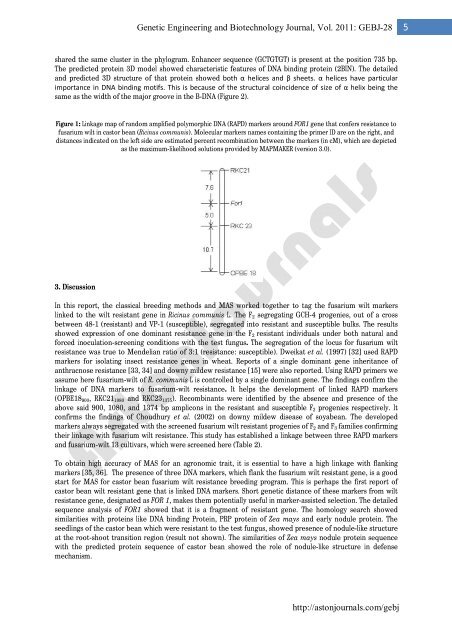
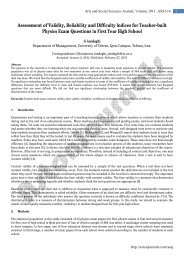
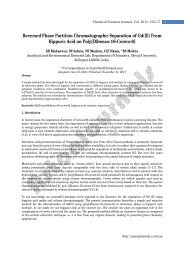
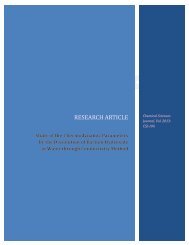

![[1,4]-benzodiazepine-2-one Derivatives as Potent - AstonJournals](https://img.yumpu.com/49117784/1/184x260/14-benzodiazepine-2-one-derivatives-as-potent-astonjournals.jpg?quality=85)
